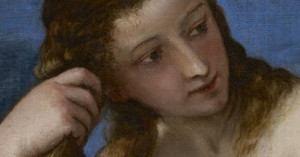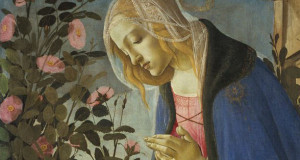NSW Art Gallery exhibits works by great painters
By Bibi Mukherjee
Currently the NSW Art Gallery is exhibiting the most impressive art works from Scotland National Gallery. The collection encompasses 70 paintings from the Renaissance to Impressionism particularly the outstanding works by great Masters. The fresco of Edinburgh skyline with the Edinburgh Castle on the Mound greets you on the entrance of the exhibition and sets the mood for what we are about to see.
The 1st room displays Sandro Botticelli’s much anticipated painting “The Virgin adoring the sleeping Christ child”. This painting was done in the later part of Botticelli’s life when his style became simpler with predominance of religious theme. This painting is also unusual as the Christ child was rarely shown asleep. The pale complexion of Christ and the pink flowers and red fruits probably are symbols of his future suffering for mankind. Botticelli’s expressive capacity transforms the painting into visions of sheer poetry.
In the same room there is Titian’s (Tiziano Vecellio’s) “Venus rising from the Sea”. Titian’s Venus, Goddess of Love has no similarity with Botticelli’s the “Birth of Venus” which is in Uffizi gallery in Florence. Titian’s Venus is powerful, elegant, voluptuous real human being not a female divinity. Titian became the greatest of the sixteenth century Venetian artist. This painting is one of the series of his mythological paintings.
Diego Velazquez was the central figure in the golden age of Spanish painting and ranks among the greatest masters of Seventeenth Century Europe. “An old woman cooking eggs”. belong to the early years of his career, he was then only eighteen years old. This painting reveals his interest in Genre painting which was just beginning to come into fashion in Spain. He practised realism and was concerned with the effect of light emanating from single source. This painting with the boy intently watching the cooking surrounded by ordinary domestic utensils is vivid and spontaneous. The gaze of the old woman gives the impression that she might be blind.
Rembrandt Van Rijn is the greatest Baroque artist in the history of Flemish art. He is one of the most talented storytellers which he did through his paintings. Rembrandt was never tired of innovation in his techniques from his early colourful historical paintings to his glowing late works. The change of styles from his early years to paintings in later date is so pronounced that you can put him to that small group of artists whose development never ceased.

Rembrandt van Rijn
A woman in bed 164(7?)
oil on canvas
81.4 x 67.9 cm
Scottish National Gallery, Edinburgh
© Trustees of the National Galleries of Scotland
The Scotland National Gallery Is very generous to lend this unique painting by Rembrandt “The woman in bed “. The painting shows a woman sitting on a bed with a pillow in her back moving a bed curtain with a faint smile and an appearance that she is expecting a visitor. It is signed dated 164, the last digit is missing. So we do not know exactly which year it was painted and who is this woman. The art critics guessed that she might be representing three women in Rembrandt’s life, his wife Saskia, his son’s nursemaid and the servant girl. Rembrandt was an ardent follower of Realism so he was never concerned about the physical beauty of the woman but all his women were painted with a touch of sympathy and a lot of compassion. The true spirit of Baroque is also apparent in this painting with its mystery and drama.
John Singer Sargent is one of the most successful and esteemed portrait painter of the modern era. He is also known for his stunning landscapes. Sargent is the only son of an American doctor from Philadelphia. He was born in Florence studied in Italy and France and settled in London. But he is acclaimed on both side of the Atlantic. Sargent’s most important portraits include those of President Roosevelt, John Rockefeller, Aguste Rodin, Claude Monet and Robert Louise Stevenson. It is a privilege to see one of his enchanting portrait “Lady Agnew of Lochnaw”. Gertrude Vernon Agnew was the wife of Sir Andrew Agnew, Baronet of the estates of Lochnaw in Galloway. It is a portrait of an elegant lady with beautiful features, sitting candidly in a colourful French armchair looking straight at the viewer. Her shimmering satin dress with lilac hash perfectly harmonizes with the whole scenery. She is sitting passively but through her passivity she portrays her personality. Her melancholy gaze stays with you long after you have left the gallery.
Lady Agnes is in company with the “Ladies Waldegrave” which is displayed in the same room, painted by most renounced English painter Joshua Reynolds. These are the three sisters, Elizabeth, Charlotte and Ann Horatia daughters of the 2nd Earl Waldergrave collaboratively working on a piece of needlework. It is an intensely alive group portrait. This painting was commissioned by their mother. The sisters are all coiffured, powdered and dressed up as if they are ready to go out for a party. If we could have eavesdropped, we might have found out whether the mother’s intention of this portrait was for potential suitors.
Reynolds was a founding member of the Royal Academy of Arts in 1768 and he was elected its first president and knighted by King George III. He created a new kind of vigour into the tradition of English portraitures. In his early painting the influence of Venetian painting was very apparent but later he fell under the spell of Baroque styles. The pose and clothes of his sitters took on a more formal antique style which is quite apparent in this painting.
The last room in the Exhibition was dedicated to the Impressionists, paintings by the big names like Gaugin, Degas, Cezanne, Seurat and Monet. In the Impressionism the nature takes the central role, the nature how we see it. These painters do not want to depict heroic events of times gone by nor to capture biblical or mythological stories. They want to preserve their impressions, their feelings in the world we live in. It is not surprising that these kind of paintings were ridiculed initially as amateurish. The term Impressionism was coined from Monet’s painting “Impression Sunrise”.
Like ”˜Haystacks’, ”˜Rouen Cathedral ”˜and ”˜Water Lily ”˜Monet captured the Poplars during different seasons and times of the day. He painted total 23 paintings on row of Poplars on the river bank of Epte, south of Giverny, his home. “Poplars on the Epte” painted 1891 was on display. I think out of all the paintings in poplar series this is the one is most delightful. Here the elegant poplars are beaming against the blue summer sky. The reflection of green poplars, white clouds and blue sky on the water balance the composition perfectly. He used a boat as a floating studio to capture the effect of sunlight. The trees were about to be sold so Monet bought those poplars in auction so he could finish his paintings.
These are only 7 out of 70 great arts by most distinguished painters of the history. This is a rare opportunity for us to view this unique collection and congratulations to the management of NSW Art Gallery.
Short URL: https://indiandownunder.com.au/?p=6011


